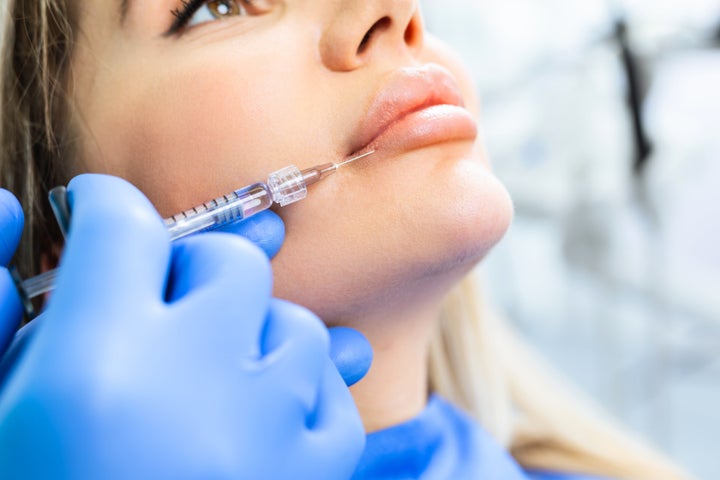
It happens every time: I stare at before-and-after photos of women who’ve gotten lip fillers, considering making an appointment. Then, as the social media algorithms are designed to do, I’m delivered videos full of warnings: “Filler migrates! It never dissolves! Look how disfigured these people’s faces are now!” The voices shout at me while I’m shown MRIs of blobs of filler that have migrated from someone’s cheekbones to behind their eyeballs.
It’s enough to scare anyone away from the seemingly simple procedure, but with dermal fillers becoming so ubiquitous, it can’t actually be as bad as these videos try to make us believe. Right?
What is filler, anyway?
Fillers are injected into the face to create a variety of looks, to add volume where it’s been lost to age or where it never existed. They plump lips, heighten cheeks, smooth smile lines and build jaw lines.
Understand that “dermal filler” comes in many forms. There are different brands, and within those brands are unique formulas, but the most commonly used are short-term fillers like Juvederm and Restylane. These are mostly made of hyaluronic acid (HA), an ingredient that naturally occurs in our skin and has been modified to create a more stable, long-lasting substance.

“Overall, HA fillers have become the material of choice due to their favorable properties: safe, long-lasting, non-immunogenic and cost-effective,” said Samuel Lin, associate professor of surgery at Harvard Medical School and a board-certified plastic surgeon. In the case that something goes wrong or the patient doesn’t like the final results, a solution called hyaluronidase can be used to dissolve the filler.
Though fillers can cause temporary swelling, they are approved by the Food and Drug Administration and are considered safe, coming with few side effects or known long-term consequences. The key phrase here is “known long-term consequences.” If you want to learn exactly how much testing a particular filler underwent in order to receive approval, the FDA publicly shares data for dermal fillers. (For example, you can read the entire methodology behind testing Juvederm Voluma.) Ultimately, if you’re not comfortable with the testing that’s been done on a product, the decision is up to you. And always make sure that you’re seeing a board-certified dermatologist or plastic surgeon.
How long do fillers last?
For those who want the convenience of a temporary filler, the marketed lifespan of these short-term fillers is six to 12 months (depending on the filler used and an individual’s lifestyle). But though the filler itself is deemed safe for use, what about all those claims of filler sticking around years later?
It’s not a surprise to Dr. Anil Rajani, who specializes in minimally invasive aesthetics (and often discusses filler on his YouTube channel). “In terms of longevity, there’s no question that these fillers last longer than what the approval studies follow for duration of effect,” Rajani said, referring to fillers he’s dissolved years after injection.
So why are we told differently? Rajani says it comes down to the FDA approval process, which looks at safety and duration, the studies of which last around six months to two years. In these studies, the amount of product remaining in the face is based on external appearance, not actual tissue sampling of what’s left in the body.
“People think that the product is totally gone at one year, which is erroneous,” Rajani said. “In fact, filler can be in the body for several years, and this is evidenced by the recent flare-ups within people’s face after receiving the COVID-19 vaccine,” he said, referring to the few patients who have experienced swelling in areas with filler. In one case, the patient had gotten the filler years earlier. “I personally have dissolved filler in my eye region from product six years prior,” Rajani said.
The body begins to absorb the filler in about four to six months, Lin added. “However, it is not uncommon for fillers to last much longer (one to two years), depending on the location, brand of filler used and injection technique.” How much filler is injected and the body’s metabolism make a difference, too, and because hyaluronic acid fillers can absorb water, it can make the fillers more visible.
How and why does filler migrate to other parts of the face?
As far as those scary-looking MRIs go (which are the exception, not the norm), there are quite a few factors behind why filler can end up beyond where it had been injected.
“A high volume of filler injected, and filler injected into high-pressure areas, can lead to filler overflowing into adjacent areas with lower pressure,” Lin explained. In the case of lip fillers, it can lead to a “filler mustache,” where filler injected into the lips spreads above the mouth.

But just because filler has migrated doesn’t necessarily mean it’s going to cause any harm. And if it does ― likely by becoming infected or forming nodules ― the filler can be dissolved with hyaluronidase. “The low-level amounts remaining in the body have not been shown to be a problem,” Rajani said. “Because it is in such small amounts, it isn’t visible to the human eye. So at this point, there are no known long-term side effects to this, but we are always monitoring.”
Lin agrees. “Filler migration and fillers that last a long time do not necessarily indicate anything unsafe.”
Though fillers are generally safe, they are not without risks. But those risks — like being injected by an untrained provider or by someone using unapproved or “black market” fillers — can be mitigated by going to a licensed professional with extensive training. “Finding the right plastic surgeon or dermatologist to perform your dermal filler procedure and optimize your safety is key,” Lin said. During your consultation, ask questions about the procedure and the filler used, and be sure you feel comfortable before proceeding.
The problems that fear-mongering content creators warn of aren’t completely without merit, but perhaps their message is overblown. Filler migration is real, and the length of time these fillers exist can surpass their marketed lifespan. But a provider who knows what they are doing can turn these into non-issues, and, most important, do so safely.